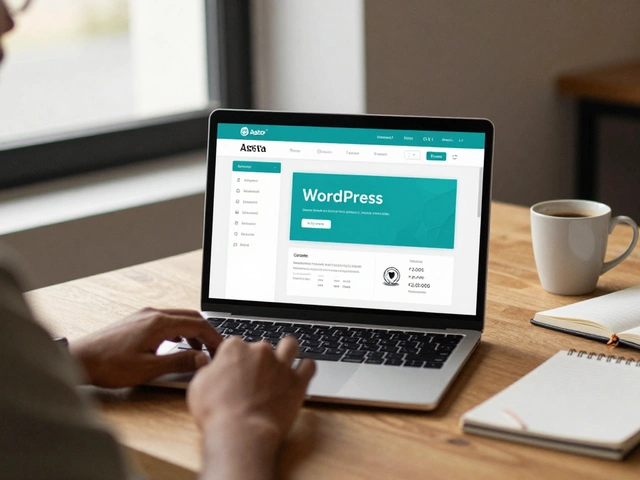You probably want to jump into blogging without a headache, right? The good news: some sites make launch-day as easy as signing up and picking a name. You don’t need to mess around with code or pay for anything if you stick with the right free platform.
Take Blogger for example—it’s run by Google, so if you’ve ever used Gmail, you’re halfway there. It also takes five minutes to publish your first post. Or maybe you’ve heard of Wix, where you literally drag text or photos wherever you want, like putting magnets on your fridge. These platforms do the techie bits for you. Choose a template, write what’s on your mind, and hit publish. It’s really that simple.
- Why Go with a Free Blog Platform?
- The Simplest Platforms and How They Stack Up
- What Makes Blogging Really Easy?
- Tips to Get Started (and Avoid Rookie Mistakes)
Why Go with a Free Blog Platform?
If you’re new to the world of blogging, the idea of paying upfront doesn’t make much sense. Free blogging sites solve that problem. You can test your ideas, write your first posts, and learn the basics using platforms that won’t cost you a penny.
Let’s be real—most people quit blogging within their first year. Starting with a free blogging site means you won’t waste money if you aren’t sure it’s your thing. Plus, almost all big-name free platforms (think Wordpress.com, Blogger, and Wix) are designed for beginners. No web design degree required.
Here’s what you actually get out of starting your blog for free:
- No setup costs. You don’t need a credit card or bank details—just an email address.
- Simplicity. Platforms like Blogger and WordPress handle security, uptime, and storage for you. No fiddling with hosting settings.
- Fast learning curve. You can see how things work, mess around with features, and make mistakes without stress.
- Access to templates. Even if you have zero graphic sense, you can choose pre-made looks that actually work on laptops and phones.
Here’s a quick peek at how some of the easiest free blogging platforms line up on popular features:
| Platform | Custom Domains | Storage Limit | Ads Displayed |
|---|---|---|---|
| Blogger | Optional | Unlimited | No |
| WordPress.com | Optional (Paid) | 1GB | Yes |
| Wix | Paid Only | 500MB | Yes |
The only catch is branding: most free sites stick their logo on your blog and your web address will include their name (like yoursite.blogspot.com). If you just want to try blogging, that’s not a big deal. Once you’re hooked, you can always upgrade later.
The Simplest Platforms and How They Stack Up
There are a lot of free blogging sites out there, but only a few are truly beginner-friendly. Let’s check out the heavy hitters and see how they line up when it comes to making an easiest blog to make.
- Blogger: You don’t need any design or coding knowledge, just a Google account. The dashboard is beyond simple, and you can connect a custom domain if you want to look more legit later. You only get basic layouts, but most beginners don’t care about fancy design. Bonus: Blogger’s backed up by Google, so it’s not shutting down anytime soon.
- WordPress.com: Don’t mix it up with WordPress.org, which is way more complicated. On WordPress.com, you just sign up, pick a theme, and start typing. You get some customization—colors, fonts, and even a few plugins on the free plan. The editor feels a bit like Google Docs, but geared for blogging. The main catch? You can’t use every plugin or theme unless you upgrade.
- Wix: Drag-and-drop makes it super easy, even if you’ve never built a website. The interface is more visual than most. You choose what you want—like an image or text block—and just move it around. Plus, Wix gives tons of free design templates, some of them way more modern-looking than other platforms. However, the free version comes with Wix ads and a not-so-pretty URL.
- Medium: If writing is your main thing and you couldn’t care less about flashy design, Medium is a solid pick. It’s all about clean posts and a distraction-free feel. You sign up, start writing, and your stuff gets shared in a huge online library. There’s basically zero setup. The main downside? Your blog is always tied to Medium’s brand—not yours.
Let’s put these facts side by side for a straight-up comparison:
| Platform | Custom Domain? | Ads on Free Plan? | Design Flexibility | Best For |
|---|---|---|---|---|
| Blogger | Yes | No | Basic | Personal blogs, simple projects |
| WordPress.com | Yes (with upgrade) | Yes | Moderate | Writers, hobby bloggers |
| Wix | Yes (with upgrade) | Yes | High | Business, creative work |
| Medium | No | No | Very limited | Writers, article sharing |
Each platform has its perks and quirks. Blogger and WordPress.com are strong on the basics. Wix nails the visual stuff, while Medium keeps things dead simple for pure writing. If you want to dip your toes into beginner blog life without any drama, any of these options can get you rolling for $0 and with next to no tech pain.

What Makes Blogging Really Easy?
There’s a reason people talk about the easiest blog to make—it comes down to a few simple details that take the hassle out of getting started. First off, any platform that handles the complicated stuff (like web hosting or security) wins major points. You shouldn’t have to know anything about coding or server settings just to say what’s on your mind.
Look for platforms with these features if you really want to keep things simple:
- Drag-and-drop editors — With sites like Wix or WordPress.com you can move text, images, and videos just by clicking and dragging. No need to touch any confusing settings.
- Free templates or themes — A handful of stylish designs are built in. You just pick one and go. No design experience needed.
- Automatic backups and updates — Your blog is safe, even if you forget to save. Plus, you never have to install anything extra; the site handles new features and security fixes.
- One-click publishing — Platforms like Blogger and Medium let you hit publish, and in seconds your beginner blog is live for everyone to read.
Easy platforms also make it simple to connect your blog with the real world. Want to share a post on Instagram, Facebook, or Twitter? Most platforms have share buttons built-in, so you just click and your story spreads.
Some sites even have built-in analytics. You'll see how many people actually read your posts without adding anything extra. Blogger, for example, shows basic traffic data right on your dashboard.
Curious which platforms top the list for "easy"? Check out this quick comparison:
| Platform | Learning Curve | Free Templates | Quick Start |
|---|---|---|---|
| Blogger | Very Low | Yes | Yes |
| WordPress.com | Low | Yes | Yes |
| Wix | Very Low | Yes | Yes |
| Medium | Very Low | Basic | Yes |
You don’t want to get bogged down before you even write your first post. Pick a simple blog platform, and you’ll spend most of your time actually blogging instead of fighting with settings.
Tips to Get Started (and Avoid Rookie Mistakes)
When you’re starting out on a free blogging site, it’s tempting to rush through setup just to get your words out. But a few quick moves up front will save you headaches later. Here’s what actually helps:
- Pick a blog name you won’t hate tomorrow. Changing your URL later can be a pain, and with some sites, it’s not even possible. Spend an extra 10 minutes making sure your blog address is catchy, easy to spell, and fits what you want to write about.
- Don’t get sucked into fancy designs too early. Go for a simple template first. Most popular free platforms like Blogger and Wix let you switch later, so focus on content instead of colors and fonts at the beginning.
- Write your first post before you customize. Seriously, just get some words on the page. You could blog about your day, how you picked your platform, anything. Once you hit publish at least once, editing and adding photos won’t feel scary.
- Add an "About" page right away. People want to know who’s behind the keyboard. Even if you keep it short ("I’m Kieran and I blog about my cat Midnight, tech gadgets, and easy recipes"), it makes your blog personal and trustworthy.
- Keep posts short and easy to read. Big walls of text scare people away. Break things into small paragraphs or add lists—most folks are just scrolling while waiting for a bus anyway.
And since mistakes happen, here are a few direct ways to dodge classic rookie moves on a beginner blog:
- Don’t share every single personal detail. You can be honest and still keep some things private. Remember, the internet never truly forgets.
- Skip copyright trouble. Use your own photos, or grab free images from sites like Unsplash or Pexels. Never pull random images off Google—Blogger and Wix both make it easy to insert safe photos.
- Write regularly (but not daily pressure). One or two posts a week is plenty when you start. No need to burn out right away—steady wins here.
- Back up your content now and then. Even the easiest blog can get wiped out by a glitch. Export posts every month. Most free platforms have this under settings.
If you’re curious which platforms give you the most out of the box, here’s a quick comparison of some easiest blog to make options:
| Platform | Sign-Up Steps | Custom Domain Free? | Free Storage Space |
|---|---|---|---|
| Blogger | 2 (Google account + blog name) | No | Unlimited (text/images) |
| Wix | 3 (email, choose template, edit site) | No | 500 MB |
| Medium | 2 (email + profile) | No | Minimal limits |
Most folks just want a spot to write without reading manuals. Stick with these tips and you’ll avoid all the newbie shock. Before you know it, you’ll have posts up, a look you like, and maybe even a few readers dropping comments.



